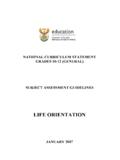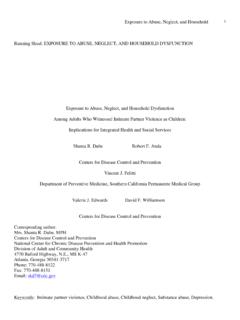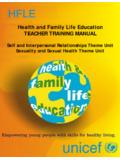Transcription of National - SchoolNet South Africa
1 National Curriculum Statement assessment Guidelines for General Education and Training (Intermediate and Senior Phases). life orientation National Curriculum Statement assessment Guidelines PREAMBLE. The assessment Guidelines are part of a developmental process that is aimed at increasing the capacity of the education system, teachers, school management teams and departmental officials to enhance the effective implementation of the National Curriculum Statements and the National Policy on assessment and Qualifications for Schools in the General Education and Training Band by developing an authentic assessment system that is congruent with outcomes based education in general and the NCS in particular. We expect a critical engagement with these documents, as they do not reflect a "zero defect" nor a "one answer" solution and we encourage all who use these documents to alert the Department of Education to any inconsistencies, highly impractical suggestions or any other elements that may detract from the goal of establishing an effective assessment system.
2 We also appeal to you to offer alternative solutions, ideas and suggestions you may have for dealing with issues you may have raised in your input. In particular, examples of good assessment tasks that enhance classroom teaching and learning will be valued. We encourage you to be as rigorous and as vigorous as you can and have complete faith in your professionalism to expect that your responses, however critical, would be framed in a constructive manner that is geared towards arriving at a shared solution and is not a simplistic listing of problems and concerns. We look forward to an exciting, growth promoting and stimulating engagement with you all. Please address any responses you may have to: Mr R. Kuhles Department of Education Private Bag X895. Pretoria 0001. email: life orientation TABLE OF CONTENTS. 1. INTRODUCTION TO THE life orientation . LEARNING AREA 1.
3 2. assessment IN THE National CURRICULUM. STATEMENT 1. 3. THE NATURE OF assessment IN THE life ORIEN- TATION LEARNING AREA 2. LEARNING OUTCOMES OF life orientation 2. WEIGHTING OF THE LEARNING OUTCOMES 3. HIV AND AIDS IN THE life orientation PROGRAMME 4. assessment STANDARDS 5. KNOWLEDGE AND SKILLS INCLUDED IN THE life orientation AS 5. 4. CONTINUOUS assessment IN THE life orientation . LEARNING AREA 6. CHARACTERISTICS OF CONTINUOUS assessment 6. FORMAL assessment 7. INFORMAL assessment 12. How to implement informal assessment 12. CASS in relation to formative and summative assessment 14. PROGRESSION IN GRADES R 8 15. CONTINUOUS AND EXTERNAL assessment IN GRADE 9 15. Common Task for assessment (CTA) Grade 9 16. Administering the CTA 17. Roles and responsibilities of the teachers 17. Writing the CTA 18. Marking of the CTA 21. Recording of CTA 26. Reporting in Grades 7 9 27.
4 National Curriculum Statement assessment Guidelines PROMOTION AT GRADE 9 LEVEL 27. CONDONATION AT GRADE 9 LEVEL 27. PLANNING FORMAL assessment 28. Planning for assessment at Learning Programme 28. Planning for assessment at Work Schedule 29. Planning for assessment at Lesson Plan 30. Step 1 Develop the assessment task 30. Step 2 Gather the evidence 31. Step 3 Evaluate evidence on learner performance 32. Step 4 Make a decision on learners' achievement 32. Step 5 Record learner performance 32. Step 6 Reporting on learner performance 33. Step 7 Reflect on the learning process 33. MANAGEMENT OF assessment 34. 5. PORTFOLIOS 34. TEACHERS' PORTFOLIOS 34. ANNEXURES. ANNEXURE 1 36. Glossary ANNEXURE 2 38. Various Forms or Types of assessment ANNEXURE 3 44. Unpacking Forms of assessment ANNEXURE 4 53. An Example of a Report Card for the Intermediate Phase ANNEXURE 5 54.
5 Recording Sheet ANNEXURE 6 55. Progression Schedule ANNEXURE 7 56. Defining the Skills in the assessment Standards ANNEXURE 8 57. Bibliography life orientation 1. INTRODUCTION TO THE life orientation LEARNING AREA. This document provides guidelines for assessment in life orientation in the Intermediate and Senior Phases of the National Curriculum Statement. It provides teachers with information on assessment as well as ways of implementing assessment in life orientation . The assessment guidelines for the Foundation Phase will be a separate document. This document should be read in conjunction with the life orientation National Curriculum Statement (NCS) Grades R 9 (Schools); National Policy on assessment and Qualifications for Schools in the General Education and Training Band; Teacher's Guide for the Development of Learning Programmes in life orientation , White Paper 6, and other current assessment Policies.
6 The purpose of the guidelines is to assist teachers in effectively assessing life orientation in the Intermediate and Senior Phases in the General Education Band by using different forms of assessment , assessment tools, techniques and methods. 2. assessment IN THE National CURRICULUM STATEMENT. assessment in the National Curriculum Statement is regarded as an integral part of teaching and learning and should be part of every lesson and teachers should plan assessment activities to complement learning activities. The informal daily assessment and the assessment programme should be used to monitor learner progress through the school year. The assessment Standards in each Learning Area define the minimum requirement for achieving the Learning Outcome at a specific Grade. We teach towards a Learning Outcome and the activities to achieve a certain assessment Standard(s) or a group of clustered assessment Standards will vary.
7 At the same time, we can assess in many different ways depending on what we would like to achieve. assessment , in general, is a process of making decisions about a learner's performance. It involves gathering and organising information (evidence of learning), in order to review what learners have achieved. It informs decision-making in education, and helps teachers to establish whether learners are performing according to their full potential and are making progress towards the required levels of performance (or standards), as outlined in the assessment Standards of the NCS. Before addressing the different types of assessment , it is helpful to list some general purposes of assessment in terms of the National Curriculum Statement; assessment in the GET band should achieve at least one of the following purposes: Develop learners' knowledge, skills and values Identify the needs of learners Enable teachers to reflect on their practice Identify learners' strengths and weaknesses Provide additional support to learners Revisit or revise certain sections where learners seem to have difficulties Motivate and encourage learners.
8 Provide information or data to a variety of stakeholders Demonstrate the effectiveness of the curriculum or a teaching strategy 1. National Curriculum Statement assessment Guidelines The purposes can be linked to different types of assessment of which the following five are listed in the National Curriculum Statement (GET: Gr. R 9). Type of assessment Description and uses Baseline assessment Baseline assessment is assessment usually used at the beginning of a phase, grade or learning experience to establish what learners already know. It assists educators with the planning of Learning Programmes and learning activities. Formative assessment Formative assessment is also called " assessment for learning". The purpose of this type of assessment is to improve learners' ability to learn. Formative assessment is planned so that it provides information about learners that they can use to deepen their understanding and the teacher can use to shape future learning.
9 The information must be used by both teacher and learner in a process of reflection and self- assessment . Thus it improves teaching and learning by giving teachers direction and enables them to adapt to learners' needs. Summative assessment Summative assessment gives an overall picture of learners' progress at a given time, for example, at the end of a term. It usually results in judgments about learner performance and can involve high stakes for learners ( Senior Certificate). There is still a place for summative assessment in the NCS but its role will be reduced. Diagnostic assessment Diagnostic assessment is similar to formative assessment , but its application will always lead to some form of intervention or remedial action or programme. It shows up either learners'. strengths and weaknesses or inappropriate teaching methodology. When it is used to find out about the nature and cause of medical barriers to learning it should be administered by specialists and then followed by expert guidance, support and intervention strategies.
10 Systemic assessment Systemic assessment is an external way of monitoring the education system by comparing learners' performance to National indicators of learner achievement. It involves monitoring of learner attainment at regular intervals, using nationally or provincially defined measuring instruments. This form of evaluation compares and aggregates information about learner achievements so that it can be used to assist in curriculum development and evaluation of teaching and learning. For the General Education and Training Band Systemic Evaluation will be conducted at the phase exit levels Grade 3, Grade 6 and Grade 9. 3. THE NATURE OF assessment IN THE life orientation LEARNING AREA. assessment in the NCS should always be seen as integral to teaching and learning. It is therefore important to understand life orientation so that the assessment can reflect the Learning Area.







